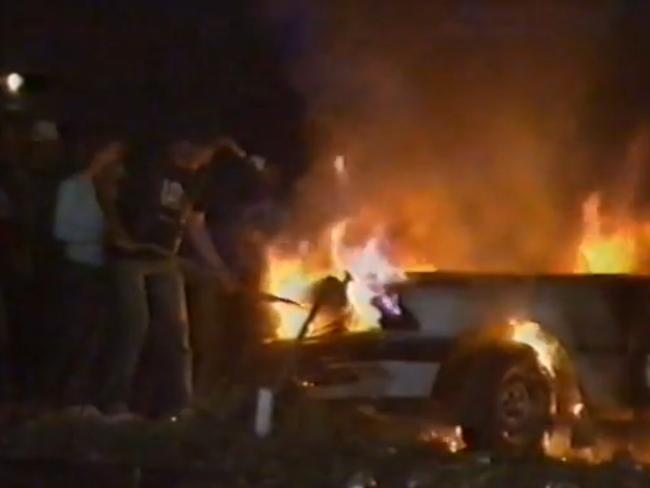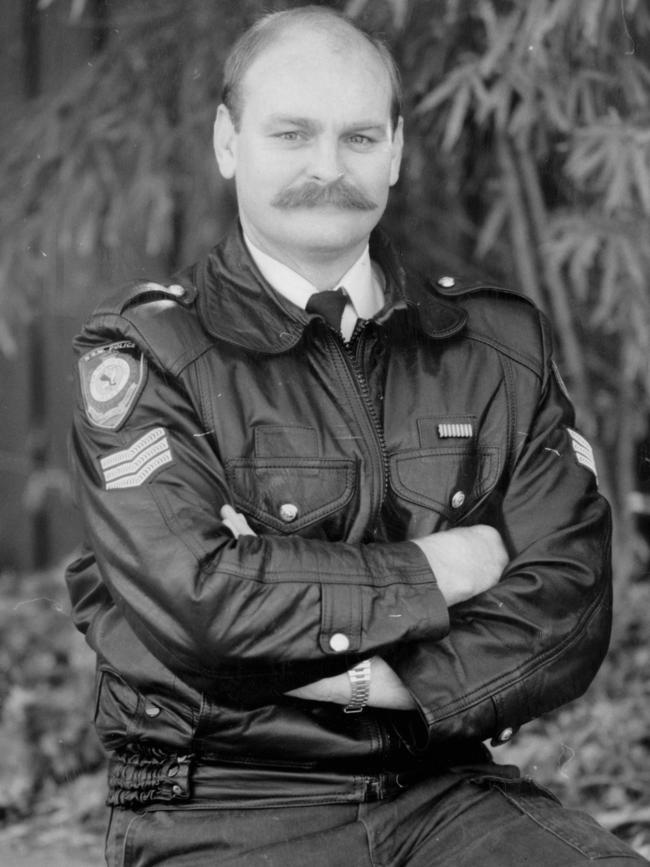‘Bring it on’: Cops stand firm against firebombs and bricks in Bathurst riots
“I was one of a team of six and out of that six we got three broken legs, a broken arm, broken fingers; everybody got set on fire at least once,” says Ron Mason of the moment police faced down wave after wave of attacking bikers. “And still we stood.” LISTEN NOW
Police Tape podcast
Don't miss out on the headlines from Police Tape podcast. Followed categories will be added to My News.
THE newspaper clippings from Easter 1983 describe the violent scenes as something akin to the movie Zulu.
And Ron Mason, who was on Mt Panorama in Bathurst that day, could not agree more, with wave upon wave of warrior bikers descending onto a police “fort” with an intent the likes of which has never been seen in Australia before or since.

The now retired NSW police superintendent yesterday recalled in vivid detail the hours of savage violence that changed forever the way police would deal with mass riot situations.
LISTEN NOW: Ron Mason on the Bathurst riots, stopping a tank and why he had to play the tough guy. WARNING: Graphic content
The veteran of almost 40 years in the police force is still known as one of the toughest cops to ever wear the NSW uniform, setting the standard for the then Tactical Response Group and its every incarnation since — a police unit largely born from what became known as the Bathurst riots.
Confrontation: Ron Mason’s dicey move as stolen tank threatens city
Family tragedy: Legendary cop driven by murder of grandmother
Mason joined the cops in 1971, aged 16, so by the time of the first clashes at the Australian Motorcycle Grand Prix at Mt Panorama he was practically a veteran.
In 1981, there were about 500 biker racing enthusiasts on the mountain and a handful of troublemakers busted for drugs, offensive behaviour and assaults. By 1982, biker fan numbers swelled to 6000, but learning the lessons from two years earlier, police got on top of the troublemakers and the event went on unaffected.
Then came 1983 and the motorcycle riding crowds alone were well over 10,000, of which thousands would form an unofficial army and lay siege to police, who were only there to ensure fans could watch the races peacefully.
“I was one of a team of six and out of that six we got three broken legs, a broken arm, broken fingers; everybody got set on fire at least once; and the only person that didn’t have fractures was heading back to Sydney because we thought he was having a heart attack when he got hit by a full house brick in the chest and collapsed,” Mason told Police Tape.
“Nothing prepared us for that. I got speared with a star picket, hit with rocks and bottles.
“I mean this is a time where they pull down a telegraph pole to take out the lights, so it was pitch black and you couldn’t see in front of you. This was where they pulled down a whole toilet block and used the bricks from the toilet block to throw at the cops.”

Bathurst police dispatched 23 officers, while up to 420 were sent from Sydney, Liverpool and Terrigal on the NSW Central Coast, but it was the 30-strong TRG squad that was tasked with taking the full brunt of the “war”.
On Mt Panorama there was a makeshift police station, enclosed by 9ft (2.75m) “anti-personnel” wiring called the “fort”, with 100 officers there at any one time.
Police reports of the day said at least 30,000 general spectators, including, families had pitched tents on the mountain.

Despite best efforts, there was a lot of alcohol to fuel what came next. Trouble started brewing in the early evening as police started breath tests of bikers entering the precinct.
Then a VW accidentally drove through the camp, agitating the bikers, who chased and bashed the driver and passenger before turning the car on its side, setting it alight and attempting to use it as a barrage against the fort.
At 9.30pm more than 2000 bikers descended on the fort with petrol-soaked toilet rolls and molotov cocktails to pelt at police and were charged back. By the second wave, the 2000 had become at least 4000.
The TRG was sent in over and over again.

“Everybody I know got injuries — bruises everywhere, your whole body,” Mason said. “Broken legs, though, broken legs were the big one, there were a lot of broken legs (from) bricks and rocks. They ordered protective equipment after that.
“We were wearing just the normal uniform, we had shin guards. I had a mate who had shin guards and he got a broken leg, but he was a hooker in rugby league and what he used to do is he would have newspapers and would strap newspapers to his leg. I mean he had newspapers strapped under the shin guards, and they still broke his leg.”
Mason concedes police made mistakes and lessons have been learnt.
“This was a time when there was some, I believe, some very ordinary decisions made, command decisions, and that caused police to get even worse injuries,” he said.
But the officers in the firing line remained defiant.
“And still we stood, still we stood, ‘Is this the best you can do? Bring it on’. And that was the attitude of the police that were there, and I just have never been so close with a group as the Tactical Response Group.”

For five and a half hours, police battled up to 5000 bikers laying siege to 100 to 120 police officers, surrounded on three sides in their compound, the courts would later be told.
Even a stick of gelignite was thrown at police, with one officer lost three toes. A second one took off a door.
One biker drove his bike at police, and ambulance and police cars were torched as thousands chanted “pigs suck, pigs suck” over and over as they marched forward.
“We were driven, not so much by the adrenaline, it’s facing the odds and coming out on top, but you feel, well I was disappointed,” Mason said. “I didn’t think Australians would behave that way. Everybody who was there would understand how bad it was, and you’d see clips from Channel 7 and what not, but it doesn’t really show the full event.”
From that night and early morning, 157 people were charged, only nine of whom were not motorcyclists. A total of 80 police were injured, with more than a dozen admitted to hospital.
Riot tactics and methods were changed from that moment, and capsicum spray was introduced, although it would be some time before police were allowed to use it. Proper body protective kit was also issued.
Originally published as ‘Bring it on’: Cops stand firm against firebombs and bricks in Bathurst riots
